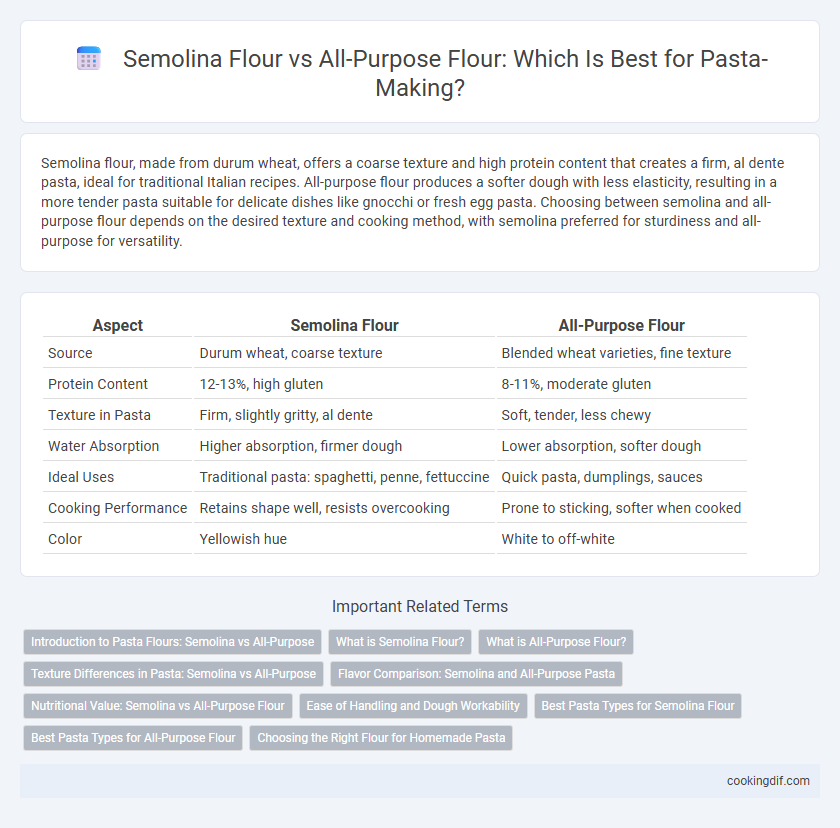Semolina flour, made from durum wheat, offers a coarse texture and high protein content that creates a firm, al dente pasta, ideal for traditional Italian recipes. All-purpose flour produces a softer dough with less elasticity, resulting in a more tender pasta suitable for delicate dishes like gnocchi or fresh egg pasta. Choosing between semolina and all-purpose flour depends on the desired texture and cooking method, with semolina preferred for sturdiness and all-purpose for versatility.
Table of Comparison
| Aspect | Semolina Flour | All-Purpose Flour |
|---|---|---|
| Source | Durum wheat, coarse texture | Blended wheat varieties, fine texture |
| Protein Content | 12-13%, high gluten | 8-11%, moderate gluten |
| Texture in Pasta | Firm, slightly gritty, al dente | Soft, tender, less chewy |
| Water Absorption | Higher absorption, firmer dough | Lower absorption, softer dough |
| Ideal Uses | Traditional pasta: spaghetti, penne, fettuccine | Quick pasta, dumplings, sauces |
| Cooking Performance | Retains shape well, resists overcooking | Prone to sticking, softer when cooked |
| Color | Yellowish hue | White to off-white |
Introduction to Pasta Flours: Semolina vs All-Purpose
Semolina flour, made from durum wheat, offers a coarse texture and high protein content ideal for firm, al dente pasta with a slightly nutty flavor. All-purpose flour, typically lower in protein and finer in texture, produces softer, more tender pasta suitable for delicate shapes and faster cooking. Choosing between semolina and all-purpose flour hinges on desired pasta texture and cooking style, influencing dough elasticity, firmness, and overall bite.
What is Semolina Flour?
Semolina flour is a coarse, high-protein flour made from durum wheat, prized for its firm texture and golden color in pasta-making. It provides excellent elasticity and a slightly nutty flavor that enhances the pasta's bite and cooking resilience. Unlike all-purpose flour, semolina's granular texture results in a sturdier dough ideal for traditional Italian pasta types like penne and rigatoni.
What is All-Purpose Flour?
All-purpose flour is a versatile wheat flour made from a blend of hard and soft wheat varieties, containing moderate protein content around 10-12%, which affects gluten development and texture. It is commonly used in everyday cooking and baking, offering a softer, less chewy pasta compared to semolina flour, which is coarser and higher in protein. While all-purpose flour produces smoother, tender pasta, it lacks the distinctive firmness and slight graininess characteristic of semolina-based pasta.
Texture Differences in Pasta: Semolina vs All-Purpose
Semolina flour creates pasta with a coarser, firmer texture due to its high protein and gluten content, which helps the dough hold its shape during cooking. All-purpose flour produces a smoother, softer pasta that is more tender but less resilient, often resulting in a creamier mouthfeel. The choice between semolina and all-purpose flour significantly influences the bite and cooking durability of homemade pasta.
Flavor Comparison: Semolina and All-Purpose Pasta
Semolina flour imparts a nutty, slightly sweet flavor to pasta, enhancing its traditional Italian taste, whereas all-purpose flour produces a more neutral and milder flavor profile. The coarse texture of semolina also contributes to a firmer bite and richer mouthfeel, making it ideal for robust pasta dishes. All-purpose flour results in a softer pasta texture that absorbs sauces differently but lacks the distinctive taste notes found in semolina-based pasta.
Nutritional Value: Semolina vs All-Purpose Flour
Semolina flour, derived from durum wheat, is richer in protein and gluten, offering a firm texture ideal for traditional pasta shapes. All-purpose flour contains less protein, resulting in a softer pasta that may lack the elasticity and bite of semolina-based doughs. Nutritionally, semolina provides higher levels of iron, B vitamins, and complex carbohydrates, contributing to sustained energy release compared to the more refined all-purpose flour.
Ease of Handling and Dough Workability
Semolina flour offers superior dough workability for pasta-making due to its coarse texture and high gluten content, resulting in a firmer, less sticky dough that is easier to handle. All-purpose flour produces a softer, more elastic dough that can be more challenging to roll and shape, often requiring more flour to prevent sticking. Pasta makers often prefer semolina for its ease of handling and ability to maintain shape during cutting and cooking.
Best Pasta Types for Semolina Flour
Semolina flour, made from durum wheat, is ideal for robust pasta types such as rigatoni, penne, and fusilli due to its coarse texture and high protein content that provide firmness and excellent bite. This flour maintains structure during boiling, making it perfect for hearty sauces and baked pasta dishes like lasagna and baked ziti. In contrast, all-purpose flour produces softer pasta suited for delicate shapes like fettuccine and tagliatelle, but lacks the durability semolina offers for traditional Italian pasta varieties.
Best Pasta Types for All-Purpose Flour
All-purpose flour, with its moderate protein content of around 10-12%, is ideal for tender pasta varieties like gnocchi, fettuccine, and ravioli that require a softer texture. Its versatility and finer grind result in dough that is easier to roll and shape, making it perfect for delicate stuffed or ribbon-shaped pastas. Unlike semolina, which offers a coarser texture and higher gluten content for sturdier pasta types like penne or orecchiette, all-purpose flour delivers a smooth, pliable dough suited for light, silky pasta dishes.
Choosing the Right Flour for Homemade Pasta
Semolina flour, made from durum wheat, offers a coarser texture and higher protein content essential for traditional Italian pasta, providing firmness and a slightly nutty flavor. All-purpose flour, with a finer grind and moderate gluten levels, produces softer, more pliable dough ideal for delicate pasta shapes and quick cooking. Selecting semolina for durability and bite or all-purpose for tenderness ensures homemade pasta achieves the desired texture and culinary authenticity.
Semolina flour vs all-purpose flour for pasta-making Infographic

 cookingdif.com
cookingdif.com